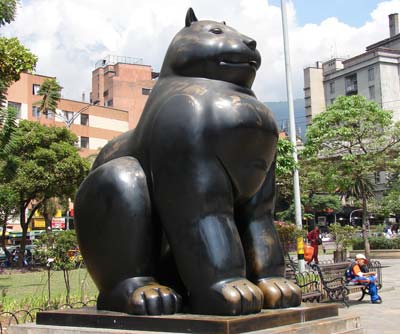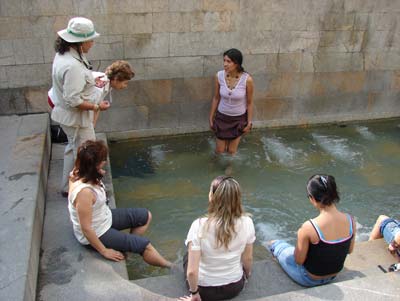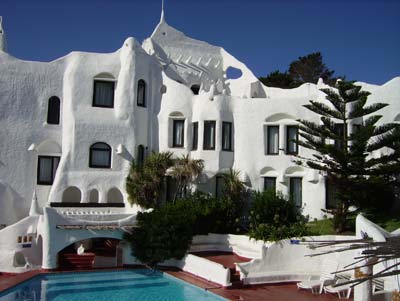Colombia, Paraguay, and Uruguay — three surprising South American destinations
by Sandra Scott, Mexico, NY
To escape northern New York’s winters, my husband, John, and I spend three months of each year someplace warmer. In 2007, our “winter getaway” was South America.
While we had been to South America several times, during this trip we found some pleasant surprises.
The new Colombia
If ever a country needed a P.R. makeover, it’s Colombia.
“I can’t believe you are going to Colombia? Aren’t you afraid?” were the most common comments when people heard we were going there. With some trepidation, we scheduled a 2-week visit.
On the drive from the Bogotá airport to the Crowne Plaza in the center of the city, my first impression was very positive. There were trees and parks along the entire way.
We spent several days wandering the historic La Candelaría area with its colorful buildings and churches, visited the museum dedicated to Colombia’s artistic icon, Fernando Botero, and took the cable car to Monserrate, topped with the El Santuario de Monserrate church, which is visible from everywhere in the city.
We also took a day trip through the tranquil countryside to Zipaquirá, renowned for its Salt Cathedral built entirely underground in a salt mine.
Medellín, the City of Flowers, was a wonderful surprise. The city has an impressive location in a deep valley with highrise buildings climbing up the hillside.
The hop-on/hop-off Turibus with a bilingual guide took us to all the highlights of the city for $6. One stop was the Park of Wishes, which includes a planetarium plus an open area with special benches and a large incline designed for people to lie down and look at the stars. Eleven interactive scientific attractions can be found in this open area.
In the unique Park of Bare Feet, with water fountains, sand areas, a Zen garden and a guadua tree park, attendants guide visitors through a series of relaxation exercises, starting with walking barefoot through the sand.
Adjacent to the park is the EPM Interactive Science Museum with a Van de Graaff generator, Disney-like science-related rides, a centrifuge ride recreating the g-force experienced by astronauts and 200 other interactive experiments.
Cartagena has really embraced tourism, and many cruise ships make it a port of call. The walled historic city is beautifully restored, with a plethora of shops, restaurants, boutique hotels and museums. Outside the historic district, hotels offer resort accommodations with swimming pools, kids’ clubs and water sports.
At no time did we experience the “danger” so often associated with Colombia. We hope to return someday to visit the archaeological park in San Agustín, with statues comparable in size and detail to the moai on Easter Island, and visit Colombia’s Caribbean islands, including San Andrés.
We stayed at the Bogotá Crowne Plaza ($120), Medellín InterContinental ($160) and Cartagena Hilton ($150).
For more information on Colombia, visit www.turismocolombia.com.
Emerging Paraguay
Paraguay has been slow to develop its tourist potential, but there were some pleasant surprises. The heart of the city of Asunción can be toured in a day, with one of the best stops being the Casa de la Independencia museum, the oldest building in Paraguay.
But the best surprise was the day train trip to Lake Ypacarai ($20) on the oldest-operating wood-burning steam engine. The actors and musicians who accompanied the train were first-rate and didn’t even ask for tips.
On arrival at the lake, we found a small handicraft market and watched a short indigenous dance presentation, then, for $2, we took a bus tour of the area.
On another day we took a short tour to several small, quiet, picturesque villages, including San Bernardino on Lake Ypacarai, where we were enchanted by the lakeside hotel that seemed frozen in time.
Our time in Paraguay was short, so we didn’t visit the Itaipú hydroelectric dam or the missions that are considered the highlights of Paraguay, but we hope to return.
From our hotel, the Crowne Plaza ($97), we could walk to the city’s historic center and restaurants.
For more information on Paraguay, visit www.senatur.gov.py.
Uruguay, South America’s best-kept secret
Only one hour by fast ferry from Buenos Aires, Uruguay offers such diversity that it would be easy to spend weeks there, which is what we did. The historic section of Colonia, our arrival city, was charming, with cobbled streets, outdoor cafés and a quiet ambience.
We stayed at the Radisson Colonia ($100), an excellent value. Located right on the Rio del Plata, it was just a short walk from the historic district.
Punta del Este is the “Miami” of Uruguay. This land arm jutting out into the ocean is dotted with highrise hotels, including the 5-star Conrad with a casino, nightly shows, a first-rate spa, two swimming pools and a beach across the street.
We saw the most spectacular sunsets from nearby Casa Pueblo, a meringue-looking museum/hotel and the former workshop and home of Uruguayan artist Carlos Páez Vilaró. Other attractions include seal- and whale-watching boat trips, art museums and golf, plus plenty of restaurants and everything people could need or want for a kick-back, upscale vacation.
Salto is an all-season destination due to its thermal waters. Our hotel, Hotel Horacio Quiroga ($114), had three pools with pure, hot water pumped from the ground. It seems that when drilling for oil in the 1940s, pockets of hot water were hit instead. The Quiroga also boasts a spa, golf course, water park and sailboats plus a variety of evening activities, including tango lessons.
We ended our visit to Uruguay with a few days at Estancia La Paz ($76), near Paysandú, and we didn’t want to leave. We loved watching the gauchos herd the sheep and enjoyed relaxing by the pool and watching the sunsets. It was a wonderful place to totally escape.
The best way to get around in Uruguay is by rental car. In most areas, the roads are good and there is so little traffic that people waved as we passed by.
For more information on Uruguay, visit www.turismo.gub.uy.
On previous trips to South America we did the tourist route: Galapagós, Easter Island, Buenos Aires and carnaval in Rio. We loved it all, but Colombia, Paraguay and Uruguay were wonderful because they presented “a road less traveled.” We knew so little about them prior to our visit that everything seemed like a new discovery.





